Review: Stanton Switch9er FS Ti-Carbon: A Mixed Material Machine
Stanton is probably best known for their steel and titanium hardtails, but their full-suspension bikes are really interesting in the way they're designed. In this case, the frame combines a titanium front triangle with a two-piece carbon fiber rear end. There's also a less expensive version with a steel front triangle and an aluminum swingarm. Those parts are cross-compatible, so you could have a carbon and steel or alloy and titanium mashup if you wanted, or upgrade the swingarm on the aluminum/steel bike.
The steel front triangles are made in the UK and the titanium frames are made in Asia, but you can also choose a titanium frame with custom geometry that's made in the UK for a £1,000 premium.
Stanton Switch9er FS Ti Details
• Intended use: trail / enduro
• Suspension travel: 140mm (r) / 160mm (f)
• Wheel size: 29''
• Titanium front triangle, carbon swingarm
• 63° head angle, 450 mm chainstays
• 15.4 kg / 34 lb (stock, size 19.5")
• Frame sizes: 16.5", 18.5", & 19.5" (tested)
• Lifetime frame warranty
• MSRP as tested: £4,409 (frame & EXT shock)
• stantonbikes.com
• Intended use: trail / enduro
• Suspension travel: 140mm (r) / 160mm (f)
• Wheel size: 29''
• Titanium front triangle, carbon swingarm
• 63° head angle, 450 mm chainstays
• 15.4 kg / 34 lb (stock, size 19.5")
• Frame sizes: 16.5", 18.5", & 19.5" (tested)
• Lifetime frame warranty
• MSRP as tested: £4,409 (frame & EXT shock)
• stantonbikes.com
It's a 29er with 140 mm travel and a 160 mm fork, using a dual-link suspension layout with some pretty unusual kinematics. It combines this with a very slack head angle but a relatively high bottom bracket. Naturally, I was keen to see how that played out on the trail.
Frame Details
Stanton was keen to stress the work they've done to maximize the frame's lateral stiffness, which they say is important for pedaling efficiency and responsiveness. This is achieved via a CNC machined part Stanton calls "the egg", which connects the bottom bracket to the lower-front pivot in a single piece; the upper mainframe pivot is nestled right at the junction of the top tube and seat tube (where the frame is naturally strong); the two links are machined from a block of aluminum and they pivot on chunky 15 mm axles.
Pivot bearings are protected by a rotary seal, which is designed to "keep the crap out the bearings". Cable routing runs through the top tube and upper part of the swingarm. That means that as the suspension compresses, the cables either have to bend or slide into the tubes. The latter could create some friction and accelerate wear on the housing, and if they can't slide they bend outwards, sometimes touching the rider's legs.
One thing to note is that the tire clearance is tight. With the 2.3" Maxxis tires (pictured), there was adequate space, but with a 2.4" Continental tire, the side knobs grazed the carbon if the bike was leaned over hard, and there are scratch marks from debris on both sides of the swingarm. I also installed a 2.5" Maxxis Assegai tyre, which had similar clearance (about 5 mm) to the 2.4" Continental. I'm not saying these tyres don't fit per se, but the clearance is tighter than most bikes and tighter than I'd like.
Similarly, the chain gets pretty close to the swingarm when you're in the biggest cogs. When the shock is bottomed out, the chain touches the carbon in gears one and two. Not that you'll spend any time in that situation, but the point is chain clearance is tight and gets tighter the deeper you get into the travel; my test bike started showing scuff marks on the carbon near the chainring after a handful of rides. Of course, you could (and should) protect the frame with some rubber strips or tape, but there isn't much room for added padding and it would be nice to see in-built protection.
Note: after publishing, Stanton sent me this image showing the chainstay protector they've developed. These will be fitted to production bikes.
There are two sets of bottle cage bosses (one under the down tube and one under the top tube), ISCG tabs, and a threaded bottom bracket shell.
Geometry & Sizing
The above chart on the left is from Stanton, showing the geometry figures for all three sizes. Stanton didn't quote the wheelbase or BB height in their chart, so I've also included my own rough measurements from my 19.5" test bike on the right.
There is a slight discrepancy in reach - I measure approximately 485 mm, which is 10 mm less than claimed. But although I measured the reach three times using two different methods, it's hard to measure reach accurately so take this discrepancy with a pinch of salt. Either way, this is slightly smaller than most bikes in the largest size, but this bike has a long 140 mm headtube plus a 10 mm external headset cup below, making for a 150 mm overall length. The tall head tube shrinks the reach number on paper because the reach is measured to the top of the head tube, so as it gets taller, the top gets further back due to the slack head angle. If the head tube was a more usual 120 mm length, the reach number would grow by 14 mm, and with an extra 30 mm of spacers under the stem, the ride position would be identical.
All that is to say that the 19.5" size bike feels as roomy as other modern XL bikes with a more typical stack height and around 500 mm reach. With my preferred 40 mm rise handlebar, I ran no spacers under the stem and the cockpit felt comfortably roomy to me at 191 cm (6'3") tall.
Suspension Design
The rear triangle is connected to the frame with a pair of counter-rotating short links. They give the bike a relatively rearward axle path near the start of the travel, meaning lots of anti-squat before the axle path curves rapidly forwards to avoid excessive pedal kickback deeper in the stroke. The layout also allows the shock to run close to parallel with the downtube, which minimizes the force on the tube and so helps to save weight.
The 65 mm stroke shock is long for a 140 mm travel bike. The leverage ratio (how many millimeters the axle moves upwards for every millimeter of shock travel) goes from 2.45 at the start of the travel to 1.55 at the end. For context, most bikes stay between 3:1 and 2:1. That low leverage makes a given shock spring or damper feel stiffer, so light spring and damping rates should be used. The overall progression (change in leverage ratio) is 37%, making it one of the more progressive designs out there. Note also that most of this progression (the drop in leverage ratio causing an increase in suspension forces) happens towards the end of the travel. For this reason, the Switch9er works much better with a coil shock with a small bottom-out bumper, like the EXT, than with an air shock which is already progressive late in the travel.
I initially tested the bike with the RockShox Super Deluxe air shock (pictured), but I wasn't happy with the performance. I talked to Stanton about this and they strongly suggested I try an EXT coil shock instead. "Maybe it's a good thing you've experienced it with that air can for comparison but, I'll be honest, that's an error for it to be sent to you with that particular shock on," Stanton told me. "There are air cans that work well with it, the ones that are more linear and coil-like in their behavior, but that Rockshox clearly isn't cutting it."
While changing the shock I noticed the lower pivot on the upper shock mount was sticky and squeaking bad enough that the swingarm was getting stuck under its own weight. I took this pivot apart and greased it, which solved the problem.
The rear triangle is connected to the frame with a pair of counter-rotating short links. They give the bike a relatively rearward axle path near the start of the travel, meaning lots of anti-squat before the axle path curves rapidly forwards to avoid excessive pedal kickback deeper in the stroke. The layout also allows the shock to run close to parallel with the downtube, which minimizes the force on the tube and so helps to save weight.
The 65 mm stroke shock is long for a 140 mm travel bike. The leverage ratio (how many millimeters the axle moves upwards for every millimeter of shock travel) goes from 2.45 at the start of the travel to 1.55 at the end. For context, most bikes stay between 3:1 and 2:1. That low leverage makes a given shock spring or damper feel stiffer, so light spring and damping rates should be used. The overall progression (change in leverage ratio) is 37%, making it one of the more progressive designs out there. Note also that most of this progression (the drop in leverage ratio causing an increase in suspension forces) happens towards the end of the travel. For this reason, the Switch9er works much better with a coil shock with a small bottom-out bumper, like the EXT, than with an air shock which is already progressive late in the travel.
I initially tested the bike with the RockShox Super Deluxe air shock (pictured), but I wasn't happy with the performance. I talked to Stanton about this and they strongly suggested I try an EXT coil shock instead. "Maybe it's a good thing you've experienced it with that air can for comparison but, I'll be honest, that's an error for it to be sent to you with that particular shock on," Stanton told me. "There are air cans that work well with it, the ones that are more linear and coil-like in their behavior, but that Rockshox clearly isn't cutting it."
The first video shows the rear suspension cycling. Notice how the brake hose bows outwards. The second video shows how the weight of the swingarm wasn't enough to overcome the friction created by the sticky pivot. Re-greasing the pivot allowed it to move freely and stopped the squeaking noise you can hear.
While changing the shock I noticed the lower pivot on the upper shock mount was sticky and squeaking bad enough that the swingarm was getting stuck under its own weight. I took this pivot apart and greased it, which solved the problem.
Specifications
Stanton doesn't sell a full-build yet so I won't dwell too much on the parts fitted to my test bike other than how they impact the overall ride.
The now superseded Hope Tech 3 E4 brakes feel great but lack power with 180 mm rotors. Maxxis EXO 2.3" tires demanded high pressures to avoid squirming and this led to a harsher ride, so I swapped these out for 2.4" enduro-casing tires to get a better sense of the Stanton's potential. My test bike came with a RockShox Super Deluxe shock due to supply issues, but I soon swapped it for an EXT Storia Lok V3.
One other thing to note is the 51 mm offset RockShox Lyrik fork versus the more common 44 mm offset, but this may only subtly affect the handling in some circumstances.
Stanton doesn't sell a full-build yet so I won't dwell too much on the parts fitted to my test bike other than how they impact the overall ride.
The now superseded Hope Tech 3 E4 brakes feel great but lack power with 180 mm rotors. Maxxis EXO 2.3" tires demanded high pressures to avoid squirming and this led to a harsher ride, so I swapped these out for 2.4" enduro-casing tires to get a better sense of the Stanton's potential. My test bike came with a RockShox Super Deluxe shock due to supply issues, but I soon swapped it for an EXT Storia Lok V3.
One other thing to note is the 51 mm offset RockShox Lyrik fork versus the more common 44 mm offset, but this may only subtly affect the handling in some circumstances.
Test Bike Setup
I had a long journey to get this bike set up in a way that worked well for me. Almost straight away I got rid of the low-rise handlebar which just wasn't tall enough in favor of my "control cockpit" made of a 40 mm-rise Renthal 'bar with a 40 mm stem. Next, I found the RockShox air shock far too progressive with the two volume spacers installed, so I removed these and experimented with air pressure, going from 30% to 35% sag; rebound was one click from fully open. I still couldn't get the air shock to provide the suppleness I wanted, so on Stanton's recommendation, I switched to an EXT Storia Lok with a 425 lb/in spring. This was too stiff so I swapped to a 400 lb/in spring for about 30% sag. I also ran the low-speed compression and rebound pretty much open, and then things started to make sense.
The fork is the 2022 Lyrik (not the latest version) so I started with 90 psi based on past experience, but I dropped this to 82 psi to get more grip on the front tire. The rebound was ten to twelve clicks from closed and compression was fully open for most trails.
I had a long journey to get this bike set up in a way that worked well for me. Almost straight away I got rid of the low-rise handlebar which just wasn't tall enough in favor of my "control cockpit" made of a 40 mm-rise Renthal 'bar with a 40 mm stem. Next, I found the RockShox air shock far too progressive with the two volume spacers installed, so I removed these and experimented with air pressure, going from 30% to 35% sag; rebound was one click from fully open. I still couldn't get the air shock to provide the suppleness I wanted, so on Stanton's recommendation, I switched to an EXT Storia Lok with a 425 lb/in spring. This was too stiff so I swapped to a 400 lb/in spring for about 30% sag. I also ran the low-speed compression and rebound pretty much open, and then things started to make sense.
The fork is the 2022 Lyrik (not the latest version) so I started with 90 psi based on past experience, but I dropped this to 82 psi to get more grip on the front tire. The rebound was ten to twelve clicks from closed and compression was fully open for most trails.
Seb Stott
Location: Tweed Valley, Scotland
Age: 30
Height: 6'3" / 191cm
Inseam: 37" / 93cm
Weight: 189 lbs / 86 kg, kitted
Instagram: Seb Stott On Bikes
Location: Tweed Valley, Scotland
Age: 30
Height: 6'3" / 191cm
Inseam: 37" / 93cm
Weight: 189 lbs / 86 kg, kitted
Instagram: Seb Stott On Bikes
Climbing
The Stanton is very efficient under power, with almost no movement in the rear suspension unless you're stomping on the gas. The effective seat angle isn't the steepest, but only on the nastiest inclines did I wish it was any more upright, as the suspension stays high in its travel even when running over 30% sag.
The coil shock added a couple of hundred grams and introduced a touch more movement when pedaling, but I preferred the climbing feel with the coil due to the suppler action over bumps which meant less momentum and traction was lost over roots and stones. Climbing felt no less efficient but was noticeably more comfortable, more supple, and more surefooted with the coil. I was running a little less sag with the coil too, which made the seat angle steeper, and although I never used it, the lockout option is there for tarmac grinds.
The Stanton is very efficient under power, with almost no movement in the rear suspension unless you're stomping on the gas. The effective seat angle isn't the steepest, but only on the nastiest inclines did I wish it was any more upright, as the suspension stays high in its travel even when running over 30% sag.
The coil shock added a couple of hundred grams and introduced a touch more movement when pedaling, but I preferred the climbing feel with the coil due to the suppler action over bumps which meant less momentum and traction was lost over roots and stones. Climbing felt no less efficient but was noticeably more comfortable, more supple, and more surefooted with the coil. I was running a little less sag with the coil too, which made the seat angle steeper, and although I never used it, the lockout option is there for tarmac grinds.
Descending
Over the first handful of rides with the RockShox shock and 2.3" tires, impressions were not good. The ride was harsh and skittish as the rear suspension (even with 0 volume spacers and 35% sag) was reluctant to engage much of its travel and react to the terrain. The bike felt hard to control and carry speed, especially on repeated bumps, steep trails, and rooty corners.
With the coil shock installed and set fully open with the lighter 400 lb/in spring, plus the bigger tires and the control cockpit, the bike finally got into its stride. The rear suspension was now supple and active, sitting nicely in its travel and reacting to bumps well. The slack head angle and long front-center make it easy to ride fast on high-speed tracks littered with pinball rocks, roots, and berms. And despite the skinny tubes, the frame feels more than stiff enough, with no obvious twist and lurching when squaring off a big catch berm.
The stable geometry often lets you forget it's only got 140 mm of travel to play with, and the suspension is unapologetically progressive even with the coil shock, so on bigger hits, it's not the most bump-swallowing. It's not for those who want to plow through rocks without care. But on the flip side, the smooth but rapid build-up of support means there's plenty to push against when pumping through corners or compressions, and the bike never squats or wallows lazily through its travel.
Despite some heavy landings, I never felt it bottom-out either. And over the small, high-frequency bumps, the coil shock tracks the ground well, giving plenty of traction at the rear.
But although the suspension was performing well with the EXT shock, there was still some rattling from the chain and the cables, which takes away from the perception of smoothness. And on some tight and steep turns, I found the Stanton less confidence-inspiring than other bikes I've been riding lately. I suspect the unusually high (355 mm) bottom bracket played a role here. The 51 mm fork offset may come into play too; although I've found with modern bikes the effect of swapping between 42 mm and 51 mm offset is subtle, the combination of the very slack head angle and the longer fork offset kicks the front axle a little further ahead than usual, and this can make it slightly harder to get weight on the front wheel.
Whatever the cause, I got more comfortable with the turn-in feel over time, but these days the difference between bikes isn't how fast they can be ridden, but how easy and intuitive it is to get up to speed. That's obviously something that's going to vary from person to person, but even with the set-up tweaks I made, it took me longer than normal to feel in tune with the Stanton. On the other hand, I can't recall a single pedal strike and that's something everyone will notice.
Over the first handful of rides with the RockShox shock and 2.3" tires, impressions were not good. The ride was harsh and skittish as the rear suspension (even with 0 volume spacers and 35% sag) was reluctant to engage much of its travel and react to the terrain. The bike felt hard to control and carry speed, especially on repeated bumps, steep trails, and rooty corners.
With the coil shock installed and set fully open with the lighter 400 lb/in spring, plus the bigger tires and the control cockpit, the bike finally got into its stride. The rear suspension was now supple and active, sitting nicely in its travel and reacting to bumps well. The slack head angle and long front-center make it easy to ride fast on high-speed tracks littered with pinball rocks, roots, and berms. And despite the skinny tubes, the frame feels more than stiff enough, with no obvious twist and lurching when squaring off a big catch berm.
The stable geometry often lets you forget it's only got 140 mm of travel to play with, and the suspension is unapologetically progressive even with the coil shock, so on bigger hits, it's not the most bump-swallowing. It's not for those who want to plow through rocks without care. But on the flip side, the smooth but rapid build-up of support means there's plenty to push against when pumping through corners or compressions, and the bike never squats or wallows lazily through its travel.
Despite some heavy landings, I never felt it bottom-out either. And over the small, high-frequency bumps, the coil shock tracks the ground well, giving plenty of traction at the rear.
But although the suspension was performing well with the EXT shock, there was still some rattling from the chain and the cables, which takes away from the perception of smoothness. And on some tight and steep turns, I found the Stanton less confidence-inspiring than other bikes I've been riding lately. I suspect the unusually high (355 mm) bottom bracket played a role here. The 51 mm fork offset may come into play too; although I've found with modern bikes the effect of swapping between 42 mm and 51 mm offset is subtle, the combination of the very slack head angle and the longer fork offset kicks the front axle a little further ahead than usual, and this can make it slightly harder to get weight on the front wheel.
Whatever the cause, I got more comfortable with the turn-in feel over time, but these days the difference between bikes isn't how fast they can be ridden, but how easy and intuitive it is to get up to speed. That's obviously something that's going to vary from person to person, but even with the set-up tweaks I made, it took me longer than normal to feel in tune with the Stanton. On the other hand, I can't recall a single pedal strike and that's something everyone will notice.
How Does it Compare?
If you're in the market for a boutique trail/enduro bike with 140 mm of travel, the Starling Murmur should be high on your list, so how does the Stanton compare?
While the Starling climbs well, the Stanton has a firmer feel under power and a slightly more upright position too, making it feel more eager on steep climbs. The Startling is perhaps a little more comfortable on flat and bumpy traverses, although you have to be a lot more careful to avoid pedal strikes.
When descending, the Starling's more linear suspension makes it feel like a longer-travel bike in the rough stuff; it swallows up big rocks that bit more readily but isn't quite as responsive when pumping. It relies on the Ohlins shock's bottom-out bumper on big landings, but that's no bad thing in my view. The geometry numbers are similar, except the Starling is a little steeper and the BB is a lot lower. I found the Starling easy to throw around and commit to corners from the off, while the Stanton took more adaptation to ride aggressively and carve turns.
Shimano Deore drivetrain
Technical Report
Shimano Deore drivetrain: The only component I haven't mentioned so far is the drivetrain. That's because Shimano's entry-level shifting didn't miss a beat and so it faded into the background in the best possible way. Yes, the gear indicator window on the shifter is useless and reminiscent of budget bikes, but the Deore drivetrain never felt lacking compared to more expensive alternatives.
Shimano Deore drivetrain: The only component I haven't mentioned so far is the drivetrain. That's because Shimano's entry-level shifting didn't miss a beat and so it faded into the background in the best possible way. Yes, the gear indicator window on the shifter is useless and reminiscent of budget bikes, but the Deore drivetrain never felt lacking compared to more expensive alternatives.
Pros
+ Slack and stable geometry make for confident handling on high-speed trails
+ Super efficient under power and composed on the climbs
+ Supple yet supportive suspension (with the right shock)
Cons
- Not the most "plough-like" even with coil
- The high bottom bracket may take time to get used to in tight or steep turns
- Cable routing and chain slap create noise; tight tire clearance; one pivot was sticky
Author Info:
Must Read This Week
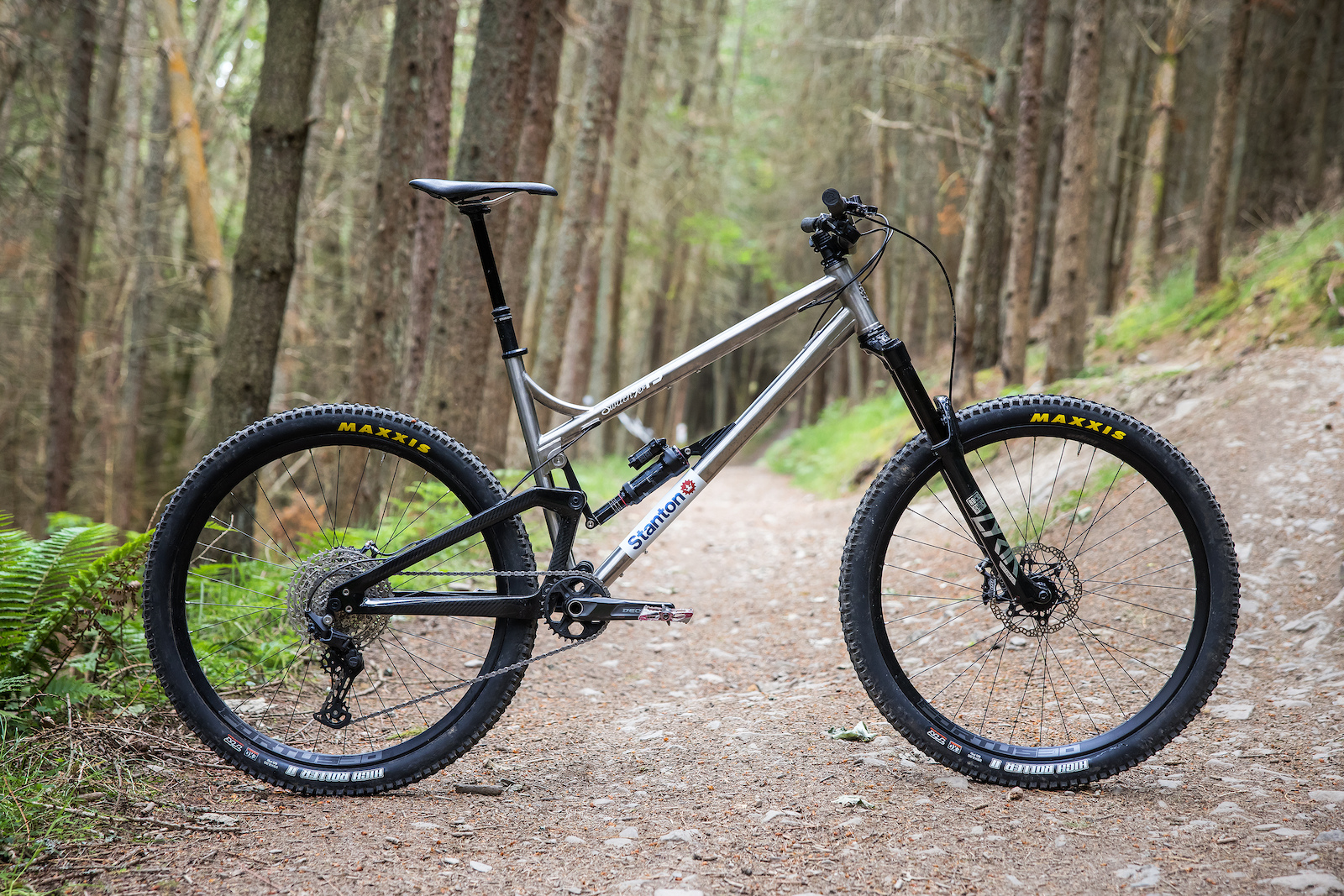
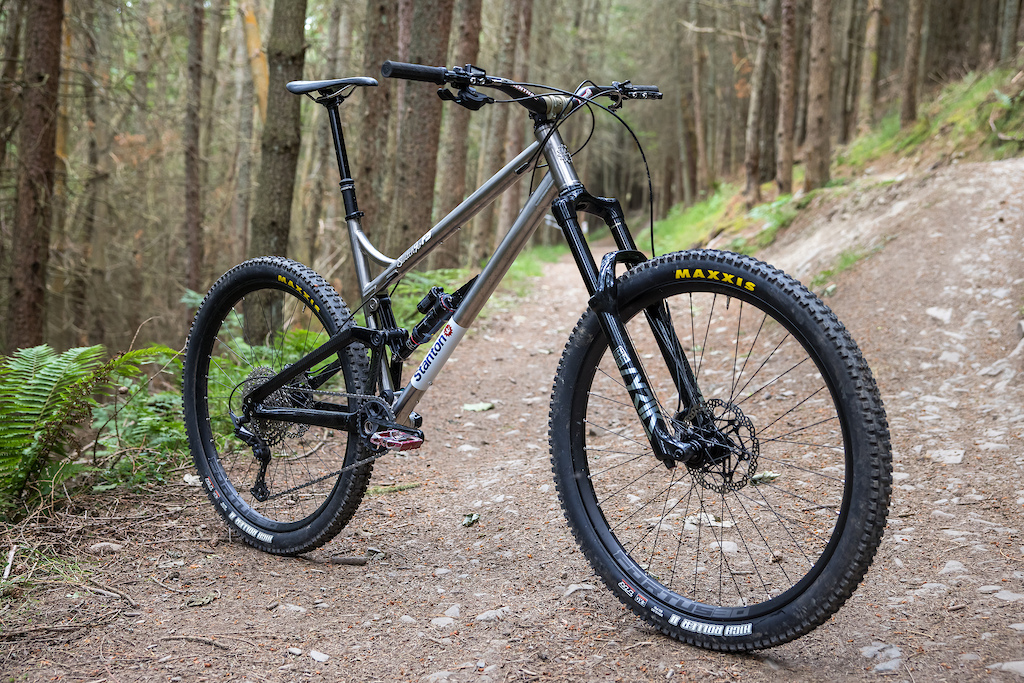







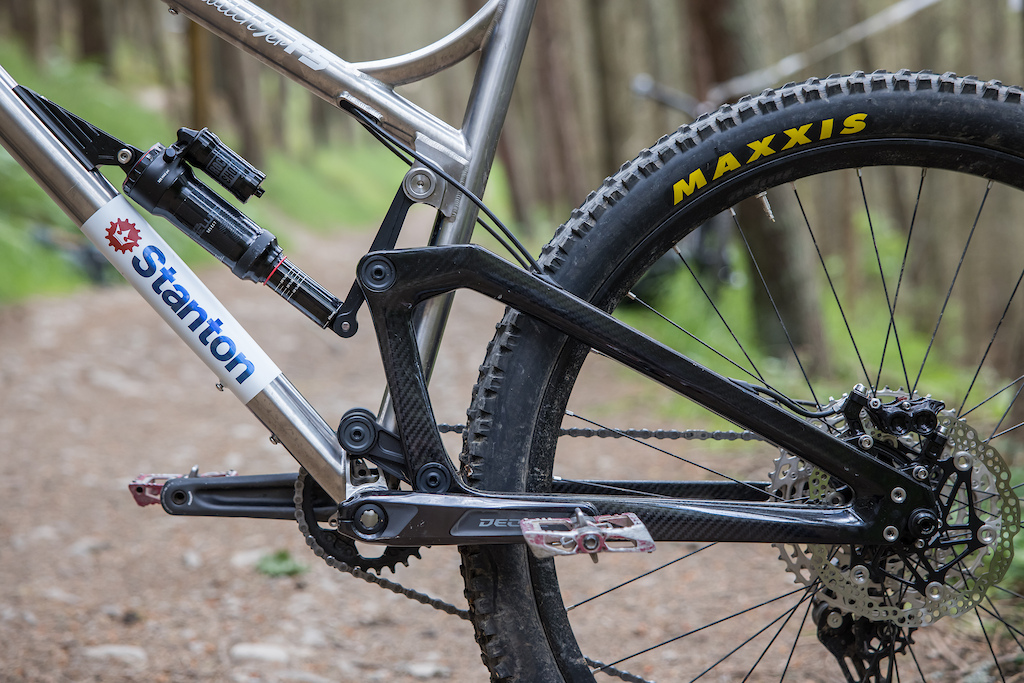



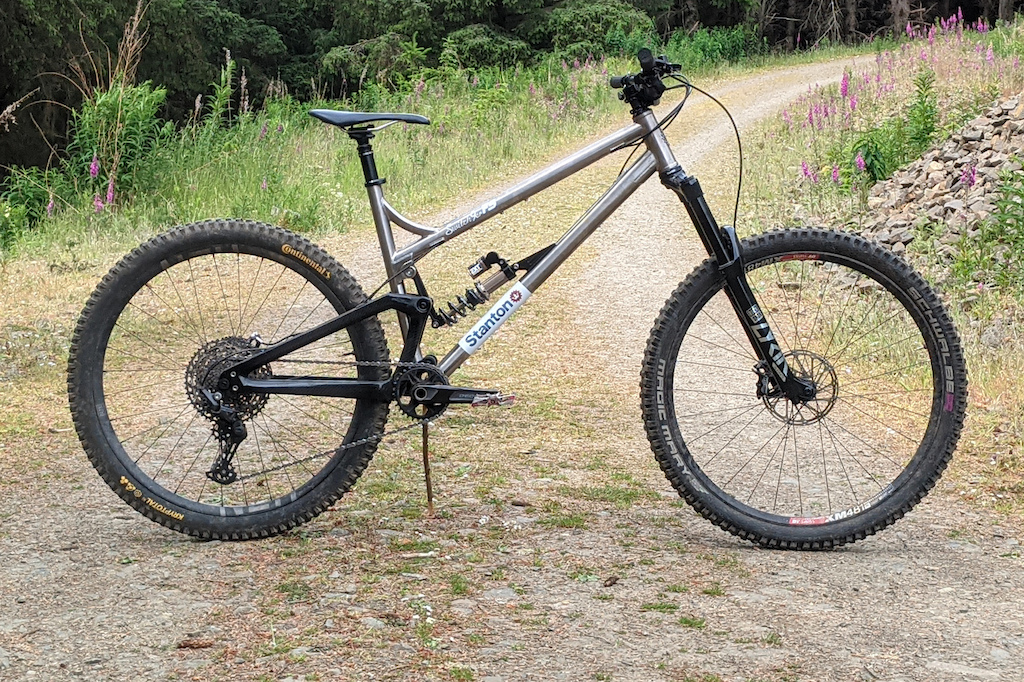


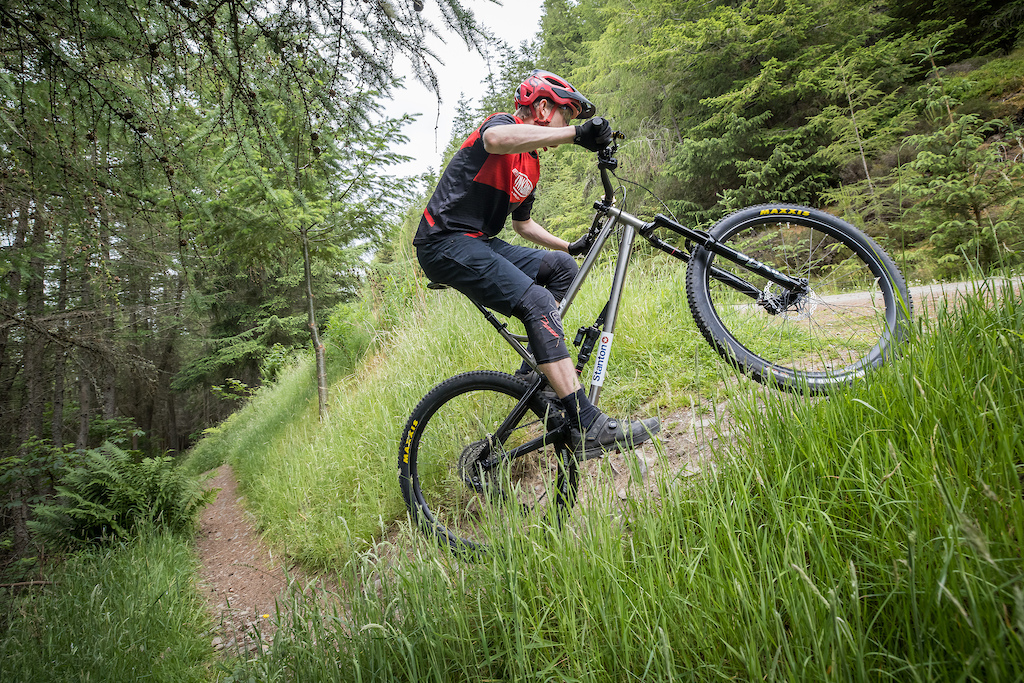


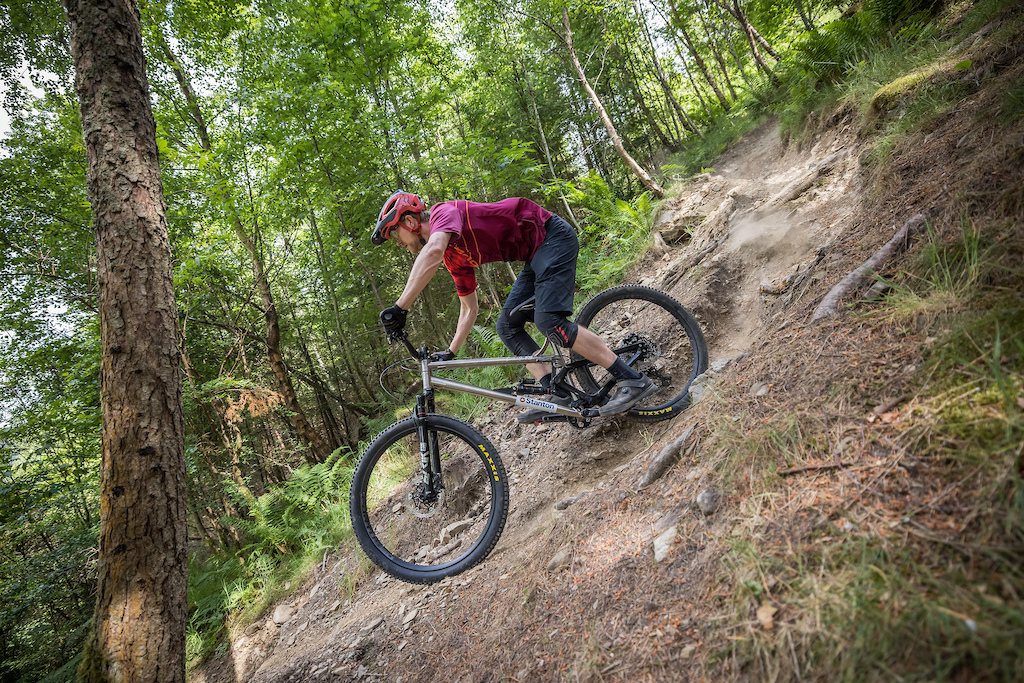


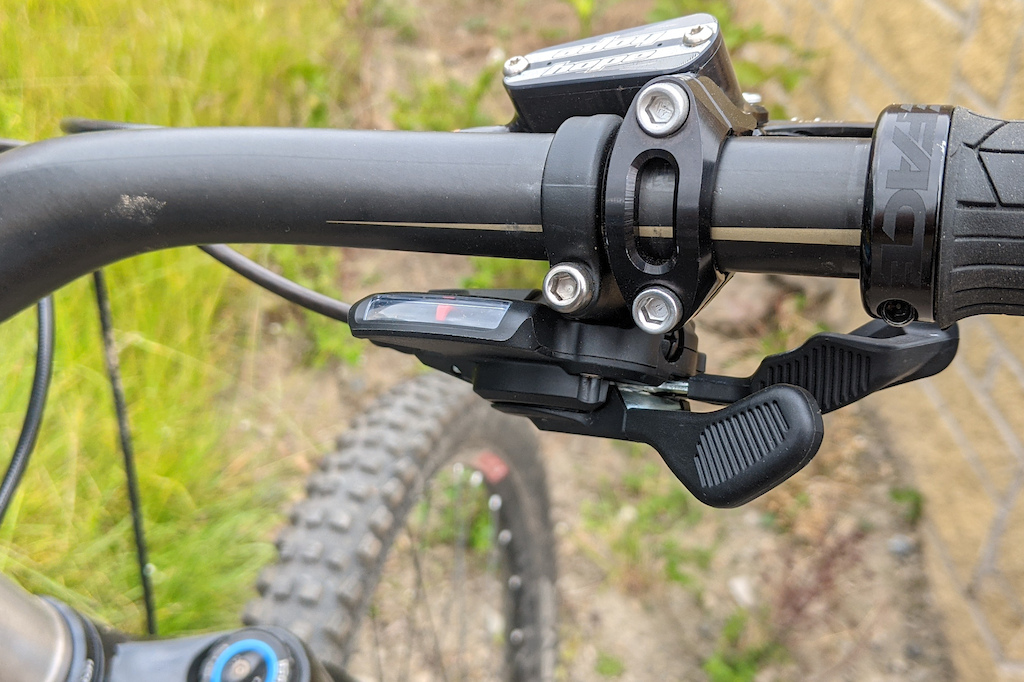



Yea but Ti with a carbon VPP rear, so...
Bottle location is actually great . I did not like it at the very begging because it is odd but the truth is that is very comfortable and practical and with time used to it . The truth is that when you ride you need to lean way less to have a quick sip and put the bottle back, while if it is placed above the BB you will need to lean lower and further back down.
What kind of rider is Steb for reference? great review
It wasnt clear...did they ship frame and shock only?
Chain clearance is tight but okay. I couldnt fit a chain guide for example. Tire and mud clearance is fine and I managed to sort out the cable slap noise (first internally routed bike so i assumed normal)
No issues with pivots.
No getting away that bling plays a part in my choice for this bike but I certainly don't find it has any 'problems'.
It pedals really well and feels plush.
The type and model is this absoluteBLACK Bash Guide Premium Chain Guide ISCG05 Mount
I run 53mm chain line and used a rear triangle protector from Yeti ARC now there is plenty( sufficient) of clearance
I put a bash on and tbh I am not missing a chain guide
Part of the reason I bought in the first place, can change travel and or wheel size by swapping out linkage or rear.
Shouldn’t of happened in either case but to list it in the Pros and Cons? really?
Since you're on a 40mm rise bar, that means there is actually plenty of room to adjust bar height down with less rise, making this not really a crazy tall stack/long headtube at all.
Of course how a bike rides is the sum and balance of many factors, so this bike could still ride harshly for other reasons.
A larger point is that dual link suspension is very hard to get right, and generally speaking is going to me much harder to set up your suspension compared to something simpler like that Starling.
Glad it can be made to work pretty well, but that shock is really long for a 140 travel bike, it's really slack, and the AS is really just sky high.
Thanks so much for doing the review PB & I especially appreciate the quality of the Seb review.
It's still the best looking bike I've ever seen.
Not too sure who gave this bike to Scott Seb all fudged up (hopefully not someone at Stanton especially with non smooth bearing). But yes you need a coil, Stanton recommends 35% sag in the rear (which Scott never ran)…and the fork offset could have mucked up the ride.
I went for the CC Kitsuma as you can dial in the damping to suit the frame. I used the TF tuned spring calculator and clicked on the vpp option and at 33% sag it recommended 307lbs. Reading the enduro-mtb.com review I went lighter and started with 275, then to 300 and on again to 325 for a while but then back to 300 and it feels great. Low speed C & R are 1-2 clicks from fully open (out of 7 I think) and high speed comp is about 5-7 from open (out of about 20 I think) with rebound 9-11 clicks from open depending on the trails. Even on the 275 I never felt the frame bottom out.
Trickiest thing was trying to get the air Lyriks to match with the progressivity of the rear... Started with 2 tokens at 30% sag, 1 HS, 2-4 LS (felt good), then tried 3 tokens with 33% sag (too harsh) and finished with 2 tokens, 33% sag 2-3 HS, 1-2 LS (plush and seems to match the rear pretty well).
Running the bike 'soft' you can edit a lot of the concerns about the high BB - that being said Seb is right, it's not a plough machine. The higher BB really does help moving from edge to edge as it were. I've mullet-ed the last 3 29ers I've owned (5'8"/70kg) for handling preference... The thought hasn't even crossed my mind with this as it handles so we'll.
Rear tyre I run WTB JUDGE 2.4 with no clearance issue whatsoever. I 3m mastic-taped the chain stay and just behind the chainlike from the front ring the bike is stealthy quiet. I do believe Stanton have some sweet factory 3m chain stay protectors for the carbon rear now.
If you're looking for a full suspension for all round UK riding you can't really go wrong with this - which flavour you get depends on your budget.
On bearings... Bumped into the raffle winner from Ardrock of the first prototype fs9er the other week at a race... He rides oop north year round and hasn't touched his bearings for 2.5 years - still smooth as!
Apologies for the ramblings but a couple of folk seemed like they were interested! :-)
Tyre clearance on that one is great although I'm old school and only run 2.4 Schwalbe rubber on Flow EX rims but never had any issue with rub. I think the talk of 'shit shelf' is possibly true, but there are many more frame manufacturers that have linkages arranged in a manner that allows for build up of crap and they don't build for UK slop. I have the externally routed cables, and yes due to movement they do bulge out a bit and rub my legs on occasion but for the bike
When getting mine we were at the beginning of not being able to get parts so I had to opt for the RS shock over the Fox X2 (at the time there was talk of X2s still going pop despite changes), the stock air-can on the Super Deluxe did mean it didn't feel quite right so I fitted the MegNeg and it transformed the feel. I did feed back to Dan that it improved things no end, but I can imagine that there's no real benefit for the guys to faff around swapping air cans and having them all laying around spare at the unit.
Bearing wise, am still on the original set. I pop them open and re-grease occasionally but they are still spot on. A squeaky seal can happen on the big brand bikes too, it just seems a bit fussy to have it as a con especially if that bike is a demo mule.
Cant talk about BB height on the 29er, I would say that on the 650 version it is low and pedal strikes are a regular occurrence in punchy tech climbs over rocks and roots in the alps etc.
No offence to reviewers out there, but the key determining factor for a bike review is personal preference. One mans trash is another mans gold, don't just take one opinion to be gospel.
I also have external cable routing and my bike is perfectly silent. Same experience with you on bearings, still smooth after 3 muddy winters since ownership.
The comments regarding the BB height, handling in steeps and absorbing big hits, in my view, would all be addressed by setting up the bike correctly. Namely, 35% sag would lower the BB at sag by around 7mm and make it easier to use more travel. If you check the EXT calculator - you should have used a 325lb spring NOT 400lb. At 6kg heavier than you I use a 350lb spring.
My previous bike was a GG Gnarvana and I did not (surprisingly) find myself longing for the extra 20mm of rear travel and found the Stanton handled steep/tech stuff better. The Stanton is a MUCH better bike to pedal.
As a side note, I have tried both EXT Storira V3 and Formula Mod on the Stanton and GG. The EXT is now for sale.
I run light tires though
Now I have only Stanton , some of the biked used to have Niner Jet RDO, Santa Cruz Tallboy, Yeti SB130 and Yeti ARC and others... have already ~2000miles on the Stanton as you said it is awesome
The thing about a suspension design like this is that it requires extremely exact pivot locations to result in the intended effect but since they missed the hta by over 1' and the reach by 10mm, the chances of them nailing the linkage pivot points is unlikely. I suspect they don't actually know what the linkage rates are supposed to be which is why they were unable to provide any charts after multiple requests. A 62.6' hta is simply too slack for a 140 trail bike that requires 35% sag to even feel correct.
I found some info on the Stanton's rear suspension on Antonio's Linkage website searching for the steel version of the same bike. While Antonio's website is great for the cost (free), it isn't super accurate ime and only gives you an approximation.
With such a low leverage ratio & high progression on the Stanton, a coil shock is mandatory. However the spring rate gaps become excessive at really low rates making getting the correct spring rate seemingly impossible. Good solution for a huge fella without having a 3# shock spring however.
The design still has merit, I'd just encourage Stanton to very carefully dial in their geo and more importantly their rear suspension design. Less AS, higher leverage ratio through the use of a shorter shock & maybe just a bit less progression (or a lot less so as to run an air shock).
The truth is, what I've realized after spending the last year on my amazing mass produced SJ Evo, is that development budgets matter, a LOT!
GL to the crew at Stanton.
Harsh ride, poor performance, carbon hitting! poor tire clearance. what on earth are they playing at? I want a premium product. ill be taking my cash elsewhere
But I think that might just be side effect of the straihgt and slender tubes. Because if you just look at the wheelbase, it doesn't look overly long IMO.
The components also make a big difference the EXT shock + EXT fork with that frame is a killer combination and it is something that has to be experienced . The bike rides very smooth and has phenomenal lateral stiffness . It;s universality will allow you to match other riders on trail bikes, XC bikes, enduro bikes . The rear has good clearance for 2.5" tire . I have run 2.5 Aggressor , 2.4" Nobby Nick, 2.4 Maxxis Aspen.
Seb has put a deceint effort and done a nice review from his point of view but the statement in the review that a 2.5" rear tire may not clear or rub is speculative and not correct..... test it and then state facts. Again not enough clearance in UK may be enough clearance in California, where rainy and muddy are remote very rare . Obviously it is not the right choice to send a low range equipped high end frame when all companies woudl have sent the top of the line equipped bikes.
If Seb was in the US, San Jose bay area I woudl gladly borrowed my bike to test and I bet the review woudl be different.
There’s so much better out there.